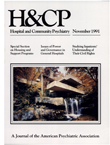Residential Programs for Persons With Severe Mental Illness: A Nationwide Survey of State-Affiliated Agencies
Abstract
About 1,500 agencies responded to a nationwide survey of community residential programs affiliated with state departments of mental health that was conducted in 1986-87. The agencies served more than 59,000 individuals who had psychiatric disabilities in more than 16,000 residential settings. The results reveal rapid growth in the number of programs since 1980 and the availability of a broad range of residential programs. Group homes and supervised apartments were the most common types of residential programs identified in the survey. The most commonly offered services were social and recreational activities, medication supervision, and on-site crisis intervention. Programs also offered such services as client advocacy and case management. Most program staff did not have professional training in a mental health field.
Access content
To read the fulltext, please use one of the options below to sign in or purchase access.- Personal login
- Institutional Login
- Sign in via OpenAthens
- Register for access
-
Please login/register if you wish to pair your device and check access availability.
Not a subscriber?
PsychiatryOnline subscription options offer access to the DSM-5 library, books, journals, CME, and patient resources. This all-in-one virtual library provides psychiatrists and mental health professionals with key resources for diagnosis, treatment, research, and professional development.
Need more help? PsychiatryOnline Customer Service may be reached by emailing [email protected] or by calling 800-368-5777 (in the U.S.) or 703-907-7322 (outside the U.S.).



